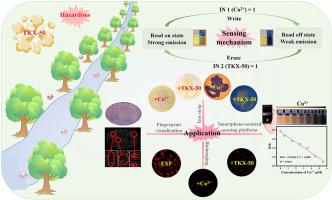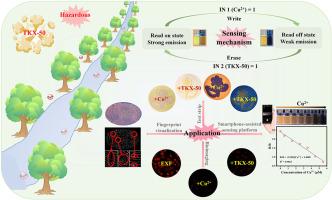用于Cu2+和TKX-50序列检测的铜桥荧光传感器:合成、机制和应用
IF 6
2区 化学
Q1 CHEMISTRY, ANALYTICAL
引用次数: 0
摘要
5,5′-双六唑-1,1′-二酸盐(TKX-50)是一种高能量、低灵敏度的新型炸药。它是犯罪分子进行非法袭击的首选爆炸物,构成了重大的安全风险。因此,开发一种高效、高特异性的TKX-50检测方法具有重要的现实意义。荧光化学传感器由于其高灵敏度、快速响应和视觉检测能力,在爆炸物检测中显示出巨大的潜力。结果设计并合成了一种新型荧光化学传感器N′-((E)-5-((E)-2-(3-(二氰乙烯)-5,5-二甲基环己基-1-烯-1-基)乙烯-2-羟基苄基)-7-(二乙基氨基)-2-氧- 2h -铬-3-碳酰肼(EXF),并用1H NMR、13C NMR和HRMS对其结构进行了表征。该传感器通过“开-关-开”荧光响应实现Cu2+和TKX-50的连续特异检测。EXF对Cu2+的检出限为0.0968 μM。配合物[EXF-Cu2+]能在多种被测炸药中特异性识别新型炸药TKX-50,检出限为0.0648 μM。本研究采用试纸对实际水样中的Cu2+和TKX-50进行了定性检测,并基于智能手机标准曲线成功实现了实际水样中Cu2+和TKX-50的定量检测。此外,EXF还可用于潜在指纹的可视化,显示了其在刑事侦查领域的潜在应用前景。EXF在Cu2+和TKX-50活细胞成像中的应用也得到了验证。荧光传感器EXF利用Cu2+作为“桥梁”,在炸药探测和离子传感之间建立了联系。该研究不仅提供了创新的爆炸物探测技术,而且为多功能荧光传感器的设计提供了有价值的原则。试纸和智能手机平台初步实现了现场快速定性、定量检测。而LFPs在活细胞中的成像与检测进一步拓展了应用领域,具有重要的实际应用价值。本文章由计算机程序翻译,如有差异,请以英文原文为准。


A copper-bridged fluorescent sensor for sequential detection of Cu2+ and TKX-50: Synthesis, mechanism, and applications
Background
5,5′-bistetrazole-1,1′-diolate (TKX-50), known as a novel explosive, is characterized by its high energy and low sensibility. It is a preferred explosive for criminals to carry out illegal attacks, posing a significant security risk. Therefore, the development of an efficient and highly specific detection method for TKX-50 is of significant practical importance. Fluorescent chemical sensors have demonstrated tremendous potential in explosive detection due to their high sensitivity, rapid response, and visual detection capabilities.
Results
A novel fluorescent chemical sensor N’-((E)-5-((E)-2-(3-(dicyanomethylene)-5,5-dimethylcyclohex-1-en-1-yl)vinyl)-2-hydroxybenzylidene)-7-(diethylamino)-2-oxo-2H-chromene-3-carbohydrazide (EXF) was designed and synthesized, and its structure was characterized by 1H NMR, 13C NMR, and HRMS. The sensor can achieve continuous and specific detection of Cu2+ and TKX-50 through the ‘on-off-on’ fluorescence response. The EXF achieved a detection limit of 0.0968 μM for Cu2+. The complex [EXF-Cu2+] could specifically identify the novel explosive TKX-50 among a variety of explosives tested, with a detection limit of 0.0648 μM. In this study, the qualitative detection of Cu2+ and TKX-50 was carried out using test strips, and the quantitative determination of Cu2+ and TKX-50 in real water samples was successfully achieved based on the standard curve of a smartphone. Additionally, EXF can be used for the visualization of latent fingerprints (LFPs), demonstrating its potential application in the field of criminal investigations. The application of EXF for Cu2+ and TKX-50 imaging in living cells is also demonstrated.
Significance
The fluorescent sensor EXF establishes a connection between explosive detection and ion sensing by utilizing Cu2+ as a “bridge”. This research not only provides innovative explosive detection technologies, but also offers valuable design principles for multifunctional fluorescent sensors. The test strips and smartphone platform have preliminarily achieved on-site rapid qualitative and quantitative detection. And the LFPs imaging and detection in living cells further expand the application field, which has significant practical application value.
求助全文
通过发布文献求助,成功后即可免费获取论文全文。
去求助
来源期刊

Analytica Chimica Acta
化学-分析化学
CiteScore
10.40
自引率
6.50%
发文量
1081
审稿时长
38 days
期刊介绍:
Analytica Chimica Acta has an open access mirror journal Analytica Chimica Acta: X, sharing the same aims and scope, editorial team, submission system and rigorous peer review.
Analytica Chimica Acta provides a forum for the rapid publication of original research, and critical, comprehensive reviews dealing with all aspects of fundamental and applied modern analytical chemistry. The journal welcomes the submission of research papers which report studies concerning the development of new and significant analytical methodologies. In determining the suitability of submitted articles for publication, particular scrutiny will be placed on the degree of novelty and impact of the research and the extent to which it adds to the existing body of knowledge in analytical chemistry.
 求助内容:
求助内容: 应助结果提醒方式:
应助结果提醒方式:


